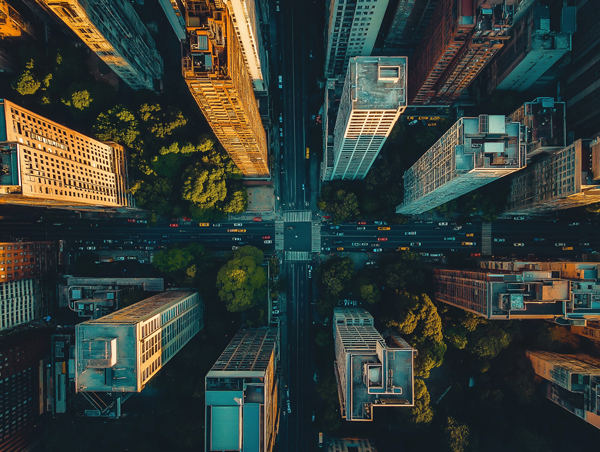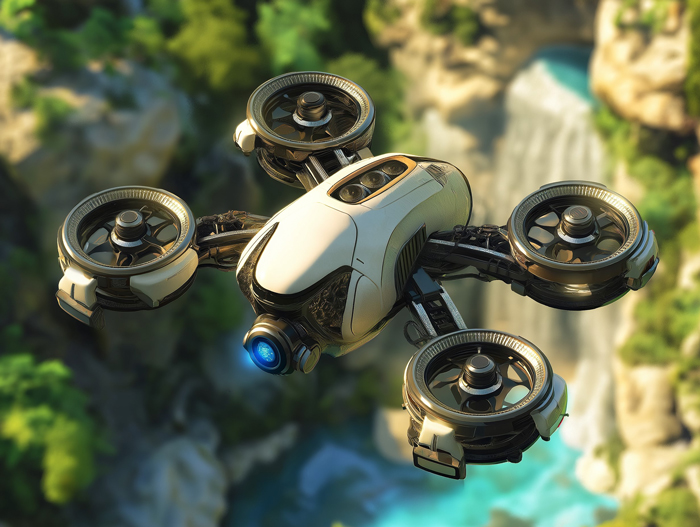Drone photography has become a game-changer in the world of photography, providing photographers with the ability to capture breathtaking aerial perspectives that were once out of reach. With the advancement of drone technology, photographers now have the power to shoot landscapes, real estate, and creative projects from unique angles, offering fresh and dynamic perspectives that make images stand out.
Whether you’re looking to capture sweeping landscapes, showcase real estate properties in an innovative way, or create stunning creative projects, drones offer endless possibilities. This guide will explore the key elements of drone photography, from selecting the right drone to mastering techniques for capturing stunning images, all while focusing on how to achieve unique and engaging aerial shots.
1. Understanding Drone Photography
Drone photography involves the use of unmanned aerial vehicles (UAVs), commonly known as drones, equipped with cameras to capture images and videos from the sky. These drones allow photographers to shoot from previously impossible angles, opening up creative possibilities and new ways to showcase subjects.
The unique aspect of drone photography is its ability to provide bird’s-eye views of the world, offering a fresh perspective on familiar subjects. Whether you’re capturing vast landscapes, cityscapes, or architectural marvels, drones enable you to shoot from high altitudes, revealing intricate details and sweeping vistas that would otherwise be challenging to capture.
Advantages of Drone Photography
•Unique Angles and Perspectives: Drones give photographers the ability to shoot from angles that would be impossible with traditional photography equipment.
•Versatility: Drones are versatile tools, useful in a variety of fields such as landscape photography, real estate, nature conservation, event coverage, and creative projects.
•Accessibility: With the development of consumer-grade drones, it has become easier for photographers to access this aerial photography medium. Drones are more affordable and easier to operate than ever before.
2. Selecting the Right Drone for Photography
Choosing the right drone is essential for achieving the best results in aerial photography. The drone’s camera, stability, flight time, and range are all factors that will influence the quality of your shots. Here are key features to consider when selecting a drone:
Camera Quality
•Resolution: Look for a drone that offers high-resolution cameras (at least 12MP, but 20MP or higher is preferable for professional work). Higher resolution is essential for capturing sharp, detailed images, especially when shooting landscapes or real estate.
•Video Capabilities: If you’re planning on shooting video, make sure the drone supports 4K or at least 1080p video quality. The ability to shoot in high resolution will enhance the video’s clarity and allow for more flexibility in post-production editing.
Stabilization
•Gimbals: A drone with a good stabilization system (such as a 3-axis gimbal) is crucial for smooth footage and sharp, stable images. Gimbals reduce camera shake caused by wind or movement, ensuring that your photos are clear and steady, even in challenging conditions.
Battery Life and Flight Time
•Battery: Battery life plays a big role in how much time you can spend capturing images. The average flight time for most consumer drones is around 20 to 30 minutes per battery. For longer sessions, it’s wise to invest in extra batteries or a drone with longer flight capabilities.
Range and Control
•Flight Range: Drones come with varying flight ranges, with some models offering control ranges of up to 5 miles or more. Make sure the drone you choose has enough range for your intended shooting area, especially if you plan to shoot expansive landscapes or real estate properties.
3. Mastering the Techniques of Drone Photography
Once you’ve selected the right drone, it’s time to master the techniques that will allow you to take full advantage of the aerial perspective. The following tips will help you create stunning aerial shots, whether you’re working with landscapes, real estate, or creative projects.
Use the Rule of Thirds
Just like traditional photography, the rule of thirds applies to drone photography. The rule of thirds divides your frame into a 3×3 grid, and you place your subject along these lines or at their intersections. This technique creates balanced, visually interesting images that avoid placing your subject dead center. When capturing landscapes, try to place the horizon along one of the horizontal grid lines and the subject of the photo, like a building or a tree, along one of the vertical lines.
Frame Your Subject
Drones provide a wide range of compositional possibilities. Use the height of the drone to frame your subject within its surroundings. When photographing landscapes, for instance, the natural features like mountains, rivers, or coastlines can create leading lines that guide the viewer’s eye toward the subject.
In architectural or real estate photography, shoot from directly above or at a 45-degree angle to showcase the layout of the property, especially in larger areas like gardens, estates, or complexes. You can also use the natural lines of the property, such as walkways or fences, to guide the composition.
Consider Lighting and Timing
The time of day you choose to shoot can dramatically influence the mood of your aerial photos. Golden hour—the hour after sunrise or before sunset—offers the softest, warmest light and provides beautiful shadows and highlights that add depth to your images. If you’re shooting a landscape, these golden tones can make hills, water, and trees look more vibrant and detailed.
For real estate, it’s best to shoot when the sun is high in the sky to avoid heavy shadows and uneven lighting. Additionally, bright, sunny days are ideal for aerial shots, as they ensure that the details of both the property and the surroundings are clearly visible.
Take Advantage of Wind and Weather Conditions
While drones are generally stable in wind, slight gusts can add a sense of movement to your images. Capturing subjects like trees, waves, or vehicles in motion can be enhanced by the wind, which adds dynamic movement and life to your shots. However, extreme winds should be avoided, as they can affect the stability of your drone and create blurry or shaky images.
Before flying, check the weather conditions to avoid flying in rain or fog, as these can impair visibility and the clarity of your shots.
Experiment with Altitude
Experimenting with altitude can dramatically change the impact of your images. For expansive landscapes, capturing a wide shot from a higher altitude gives a sense of scale, making the subject appear vast and overwhelming. Lower altitudes, on the other hand, help create more detailed, intimate shots, focusing on specific elements like a lone tree or building. When photographing architecture or real estate, try different altitudes to capture the building from various perspectives—bird’s-eye, three-quarters view, and straight-down for overhead shots.
Focus on Unique Perspectives
One of the greatest advantages of drone photography is the ability to shoot from unique, previously unattainable angles. Try capturing your subject from directly above, below, or at unconventional angles to highlight shapes, patterns, and symmetry. This approach is particularly useful in creative projects, where unusual perspectives can make a photo stand out.
For landscapes, experiment with sweeping panoramic shots to capture the vastness of the scene. In urban settings, shooting from above gives you the chance to explore the grid-like patterns of streets and buildings, while capturing areas of interest in a single frame.
4. Drone Photography for Real Estate
Drone photography is revolutionizing real estate marketing by offering dynamic aerial views that traditional ground-level shots cannot provide. Aerial images highlight the property’s layout, proximity to surrounding areas, and the overall scope of the land, providing potential buyers with a better understanding of the space.
Best Practices for Real Estate Drone Photography
•Capture the Surroundings: Aerial shots of real estate properties can showcase not just the building but also its surroundings—such as gardens, patios, or nearby parks. This is especially helpful for large estates, waterfront properties, or homes located in scenic areas.
•Focus on Key Angles: When photographing homes, the front view is important to emphasize curb appeal, while backyard views provide insight into private outdoor spaces. A 45-degree angle shot gives depth to the property’s design and layout.
•Use a Consistent Style: Keep a consistent style for your real estate drone shots. Ensure your composition remains clean and balanced, with the horizon level and the building centered. Buyers are often more focused on the property’s layout than artistic flourishes, so clarity and professionalism are paramount.
5. Creative Drone Photography
Drone photography also allows for stunning creative projects, where the photographer can push the limits of imagination. Drones can create surreal landscapes, abstract compositions, and visually captivating patterns that would be difficult to achieve with traditional photography.
Best Creative Practices for Drone Photography
•Exploring Patterns: Use drones to capture repeating patterns and symmetry found in nature, architecture, or urban settings. The bird’s-eye view reveals intricate designs and compositions that are not easily seen from the ground.
•Storytelling through Angles: For conceptual or storytelling-driven images, drones allow you to set a dramatic tone through unique angles and perspectives. Create narrative-driven photos where the subject interacts with the environment in unexpected ways, such as a person walking along a winding road or a lone figure standing in the middle of a vast landscape.
Experiment with Motion
While drones are known for still shots, they also allow for dynamic, moving imagery. Use slow-motion or long-exposure techniques to create motion blur in your drone shots, such as capturing flowing water, moving clouds, or traffic below. These creative effects add dynamism and a sense of life to your photographs.
6. Post-Production for Drone Photography
Post-production plays a key role in enhancing your drone images. While the camera and lenses do a lot of the work, editing allows you to correct any imperfections and bring out the best qualities in your photographs.
Editing Drone Photography
•Color Correction: Adjust the colors to enhance the vibrancy of the landscape, sky, or architecture. Often, aerial images can benefit from increased saturation, especially in the greens of nature or the blues of the sky.
•Exposure and Contrast: Use editing software to adjust the exposure and contrast to bring out the fine details in both shadows and highlights. Be careful not to over-edit, as the natural lighting and atmosphere often play a significant role in aerial photography.
•Straightening Horizons: A common challenge with aerial photography is keeping the horizon straight. Use editing tools to adjust the horizontal alignment and ensure the image remains level.
Conclusion
Drone photography offers photographers a unique and powerful tool for capturing stunning, dynamic images from a fresh, aerial perspective. Whether you are shooting landscapes, real estate, or creative projects, drones provide endless opportunities to create compelling visuals that stand out. By mastering the technical aspects, using creative compositions, and experimenting with angles, lighting, and post-production, you can produce extraordinary images that capture the imagination.
As drones become more accessible and technology advances, the possibilities for aerial photography continue to grow, offering photographers the ability to push boundaries, explore new perspectives, and capture moments that would have been impossible just a few years ago. With patience, skill, and creativity, drone photography can help you bring your vision to life and create unforgettable images from above.

Drone Photography: Capturing Unique Aerial Perspectives
731
previous post



